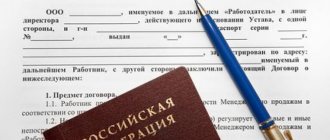Forgery of documents
A document is a material medium that contains information of any form (text, sound, image). A document always has special features that allow it to be distinguished from similar materials. The purpose of the document is for public use.
Responsibility for the intentional unlawful use of false documents is provided for by the same articles of the Criminal Code of the Russian Federation as the production of such documents. But this is only a minimum, since the fraudster’s guilt will be aggravated depending on the specific case of using the counterfeit.
So, for example, if a fraudster uses a fake travel card and rides public transport for free, he faces a fine of up to 80 thousand rubles. (or in the amount of his six-month income). Or if, for example, a fraudster used a fake higher education diploma when applying for a job, he may be punished with compulsory work for up to 480 hours, correctional labor for up to 2 years, and even six months of arrest. Receiving funds from a bank using a forged document is qualified under at least two articles of the Criminal Code of the Russian Federation - forgery and fraud in the field of lending.
A lawyer will help you understand the elements of a specific crime and will tell you the scope of the fraudster’s liability.
Do you have any questions?
To get the most detailed advice on your issue, you just need to follow any of the suggested options:
- Request a consultation using the form
on our website - Or just call the number: 8 800 350-83-74
Is it possible to imitate a signature on documents legally?
The law does provide for a special opportunity to “forge” the signature of the head of an organization. We are talking about a facsimile, that is, a special seal on which a real signature is engraved.
The use of facsimiles is absolutely legal if the organization has a procedure for its use. Trusted employees can sign by facsimile on the organization’s documents, including tax reporting. Thus, they do not find themselves in the awkward position of having to forge a manager’s signature, committing a formal violation.
Article for forgery of documents
Forgery is the production of an official document (granting rights, confirming authority, facts, etc.). The types of forgeries are varied - certification with a handicraft seal and affixing false stamps, re-sticking photos, erasures or additions, etc. A document of various levels can be forged - from a subscription to a swimming pool to a will to a sports complex, from a birth certificate to a pension certificate. They forge signatures on invoices for receiving property, commercial offers and contracts, strict reporting forms, certificates for receiving state awards - any documents giving the right to acquire any benefit.
Note!
Forgery is considered an accomplished crime from the moment the false document is produced, and it is important that the manufacturer has the intent to sell it or use it for criminal purposes.
Responsibility for falsifying a document begins at the age of 16.
Several years ago, the Criminal Code had only one article establishing punishment for forgery of documents. The sanctions it establishes for a crime without aggravating circumstances are:
- restriction of freedom up to 2 years;
- forced labor for up to 2 years;
- arrest for up to six months;
- imprisonment for up to 2 years.
Note!
A competent defense attorney will be able to find arguments that will allow, if not to avoid punishment, then at least not to lose his freedom.
If a document is falsified in order to hide another crime using a forgery or to facilitate its commission, the offender faces forced labor or imprisonment for up to 4 years.
Forgery of commercial documents falls under Article 327 of the Criminal Code, and the crime, as a rule, also contains signs of fraud.
Production of counterfeit excise and special stamps, marks of conformity
Currently, the Criminal Code separately prescribes liability for counterfeiting for the purpose of selling excise and special stamps and marks of conformity. Such crimes are punishable by a fine of up to 300 thousand rubles. (or in the amount of the offender’s income for 2 years), forced labor or imprisonment for up to 3 years. If, for marketing purposes, excise or special stamps for marking alcohol and tobacco products were counterfeited, the punishment is more severe. At the discretion of the court, this may be:
- fine up to 0.5 million rubles. (or in the amount of the perpetrator’s income for a period of up to 2 years);
- forced labor for up to 5 years;
- imprisonment for up to 8 years with a possible fine of up to 1 million rubles. (or the culprit’s income for 5 years).
Forgery of documents for medicines and medical products
The Code also covers falsification of documents for medicines and medical products. Thus, forgery of a certificate of conformity, instructions for use, technical, operational and similar documentation is punishable by:
- fine up to 1 million rubles. (or in the amount of the perpetrator’s income for a period of up to 2 years);
- forced labor for up to 3 years;
- imprisonment for up to 3 years.
Committing a crime by an organized group entails liability in the form of imprisonment for up to 10 years with possible deprivation of the right to hold certain positions (engage in certain activities) for up to 3 years.
Official forgery
Particular attention is paid to liability for forgery of official documents by employees of government agencies and local authorities. Official forgery is punishable:
- a fine of up to 80 thousand rubles. or in the amount of the perpetrator’s income for up to six months;
- compulsory work up to 480 hours;
- correctional or forced labor for up to 2 years;
- arrest for up to six months;
- imprisonment for up to 2 years.
If official forgery has caused a significant violation of the rights and interests of citizens, organizations, society or the state, the perpetrator will be punished:
- a fine of up to 1.5 million rubles. or in the amount of income for a period of up to 3 years;
- forced labor or imprisonment for up to 4 years with possible deprivation of the right to hold certain positions (engage in certain activities) for up to 3 years.
There is also strict liability for entering knowingly false information into documents that allow illegal acquisition of Russian citizenship. Such official forgery is punishable by:
- a fine of up to 300 thousand rubles. or in the amount of the perpetrator’s income for a period of up to six months;
- compulsory work up to 480 hours;
- correctional labor for up to 2 years;
- deprivation of the right to hold certain positions (engage in certain activities) for up to 3 years;
- forced labor for up to 5 years;
- imprisonment for up to 5 years.
How to recognize a forged signature and why it is dangerous
But with the emergence of new threats and dangers, the old ones have not gone away, including forgery of a handwritten signature. Meanwhile, the signature has a special meaning, and the meaning is the most practical - it, sometimes without seals and stamps, confirms the authenticity of the signed agreement, receipt, order or other document.
No matter how falsifiers have been punished in all centuries, no matter how much torture and sanctions they have been subjected to, there are no fewer fakes, they simply change with the times. The only thing that was definitely achieved was the perception of the word “fake”, especially when it comes to forging a signature, as an exclusively negative event. This word is perceived as something criminal or, at least, illegal.
But in fact, not every imitation of someone else’s signature is socially dangerous and criminally punishable, and some do not entail negative consequences at all. Rather, on the contrary – drawing other people’s signatures is now common, one might even say, an everyday phenomenon. And this is not a spirit of the times, but something that our grandfathers also sinned with if they happened to study at school. After all, as long as the school diary exists, careless students sign in it for their parents called to school. However, young cunning children will not be sent to the dock for such tricks.
You can encounter harmless fakes in adult life. For example, when, at the request of fellow workers, they receive their salaries, of course, by signing the payroll. And such an act becomes criminal only on the condition that the money does not reach the person who earned it.
What about work colleagues! Managers are often completely calm about their subordinates forging their signatures, or even ask them for this favor, just so as not to come to work because of the need to just put a pen stroke on an insignificant document. Thus, in one of the departments of the Ministry of Internal Affairs, where the author happened to work some time ago, in the absence of the boss, his signature (with his consent) was skillfully copied by one of the ordinary employees. On this occasion, the boss himself, proud of the extraordinary abilities of his subordinate, said more than once that he could not distinguish his signature from the one reproduced by this employee.
By the way, there are also situations when people sign for the boss without his knowledge. So we have to increase our vigilance. A familiar manager of one small company said that he discovered the fact of such arbitrariness of an employee due to the fact that he uses a unique signature to sign each type of document, that is, he signs orders for the enterprise with a “squiggle”, financial documents with a more legible signature with a transcript, etc. And the employee he exposed did not know about this secret trick of the boss.
In general, you can’t go over all the options for a relatively harmless and, again, relatively harmless imitation of someone else’s signature, and there’s no need to. The main thing is that such pranks do not lead to the dock, although they do not exclude punishment with a “belt”, reprimand, dismissal, tax audit, etc. depending on the specific situation.
But if the signature was drawn from selfish motives, then its legal assessment becomes different. Depending on the direction of the attacker’s intent and the harm caused by him, it is already determined by the Criminal Code of the Russian Federation (hereinafter referred to as the Criminal Code of the Russian Federation). The Criminal Code of the Russian Federation provides for criminal liability directly for forgery of documents only in isolated cases, for example:
- in Art. 142 “Falsification of election documents, referendum documents, all-Russian voting documents”;
- Art. 233 “Illegal issuance or forgery of prescriptions or other documents giving the right to receive narcotic drugs or psychotropic substances”;
- Art. 327 “Forgery, production or circulation of counterfeit documents, state awards, stamps, seals or forms.”
But investigative and judicial practice indicates that more often counterfeiting is considered not as an independent element of a crime, but as a method of committing crimes. For example, the commission of a significant part of fraud (Article 159 of the Criminal Code of the Russian Federation) became possible only thanks to a well-fabricated signature on a document.
Punishments for all these articles vary greatly. It turns out that the measure of responsibility rather depends on the purposes for which the signature and documents were forged.
Forgery of signatures on documents
The Criminal Code does not contain a separate article for falsifying signatures on documents. Forgery of a signature is equal to forgery of the document as a whole. Responsibility for falsifying a signature is similar to the responsibility provided for falsifying a particular document.
Note!
A forged signature on a document is easily recognized during an examination, which should be remembered when signing for other persons, even without malicious intent. For example, by signing for a controller to accept products or for an accountant to accept cash, you may in the near future become accused in a criminal case.
Grounds for criminal liability for imitation of a signature
The guilty subject will be held criminally liable for imitating someone else's autograph on an official document if the following circumstances are established (proven):
- If it is proven in court that the accused person maliciously falsified the autograph of another person, having a personal interest in the appearance of a forged signature on this paper.
- If the presence of a specific person’s autograph on this document clearly contributes to the achievement of the personal (selfish) goals of the guilty subject.
A person who falsifies someone else's autograph on an official paper must have an obvious selfish motive for committing such an illegal act. If a citizen imitated the signature of another person, but did not have evil intentions or selfish expectations, and the content of the signed paper did not change after such falsification, he will not be held accountable under the provisions of the Criminal Code.
If a citizen specifically corrected specific information in the documentation or forged the autograph of another person, he is subject to punishment if the fact of such forgery is officially established. In this case, the investigation must confirm that this paper is falsified. In addition, you will need to prove that the autograph affixed does not belong to the person whose name is indicated on this document.
What does forgery of documents mean?
In the Criminal Code of the Russian Federation, the concept of forgery applies only to state and municipal employees and officials.
Official forgery of documents means the introduction of false information or corrections into them that distort the content. The motive of the attacker is self-interest or other personal interest.
If we are talking about ordinary citizens or organizations, the term “fake” should be used.
Counterfeiting is the production or selection of all components of official paper (letterhead, text, seals, stamps) or the illegal alteration of individual parts of the original.
Forgery is the alteration of official documents by an official.
Signs of a forged document
Each method of making a forgery has specific features. It is almost impossible to carry out such actions unnoticed. This is what criminologists use.
- Erasing
After it, you can see a change in the gloss of the top layer of paper, you can notice smeared ink, dye residues, and a decrease in the thickness of the paper.
- Addendum
Signs of additional writing are differences in handwriting or color shades, violation of the symmetry of the text, blurry strokes.
- Changing text
If the text has been corrected, experts notice doubleness, thicker strokes, and extra elements remaining from the previous sign.
- Replacing parts
A deliberately forged document may differ from the original in series and number; most likely, the integrity of the seams holding the pages together, the numbering order, etc. are violated.
If another photo was pasted into the passport, the expert will see it under a microscope, paying attention to discrepancies in the lines of the background grid, traces along the edges of the paste, and a different color of the paper.
Regardless of whether a complete or partial forgery method is used, traces of changes and discrepancies with the original remain.
What does the article of the Criminal Code of the Russian Federation say?
In order for a person’s actions to be regarded as a crime falling under Article 327 of the Criminal Code of the Russian Federation, they must meet a number of conditions. First and most importantly, the falsification was carried out in relation to official documents or certificates that are used to obtain benefits or exemption from duties. However, simply producing falsified papers will not entail punishment under Article 327; the offender must use a fake ID or transfer it to another person.
The issuance of fake seals, stamps, awards and forms is also considered to be forgery of documents. The current Criminal Code does not have a clear definition of the concept of “forgery of documents.” The following actions are considered to be falsification of documents:
- production of fictitious documentation using special equipment;
- use of forms obtained illegally;
- making corrections to an existing document;
- correcting all or part of the text of a document by erasing, cutting, washing out or erasing;
- use of illegally manufactured stamps and seals;
- adding notes and notes to an existing document.
Changes to the text of a receipt, form or certificate can be made mechanically, as well as using printing technology and chemicals. It is important to note that forgery of documents will not be considered a crime and will not fall under Article 327 of the Criminal Code if the documents produced do not provide benefits, rights or other advantages. Also, liability is not provided for persons who falsify awards from other countries.
In order for a citizen to be punished for fraud with official forms, certificates or seals, his actions must have direct intent, that is, the person knows that he is falsifying papers for personal gain. It realizes the possible harm from its action and commits it anyway.
When there is no responsibility
There will be no punishment in the following cases:
- the forger is under 16 years of age;
- the person who committed the crime is declared insane;
- there are no signs of this offense, that is, the suspect used a real, but someone else’s passport. In this case, liability arises under another article.
The corpus delicti is considered absent in the case when documents are falsified that do not provide any powers or exempt them from them. Also, counterfeiting awards of foreign countries is not subject to punishment.
Limitation periods
The terms depend on the type of offense:
- according to Part 1 of Art. 327 the maximum penalty does not exceed 3 years in prison. The statute of limitations is the shortest - 2 years;
- according to Part 2, the term of imprisonment is more than 3, but less than 5 years. Here the statute of limitations is already 6 years;
- According to Part 3, no imprisonment is provided, the statute of limitations is 2 years.








